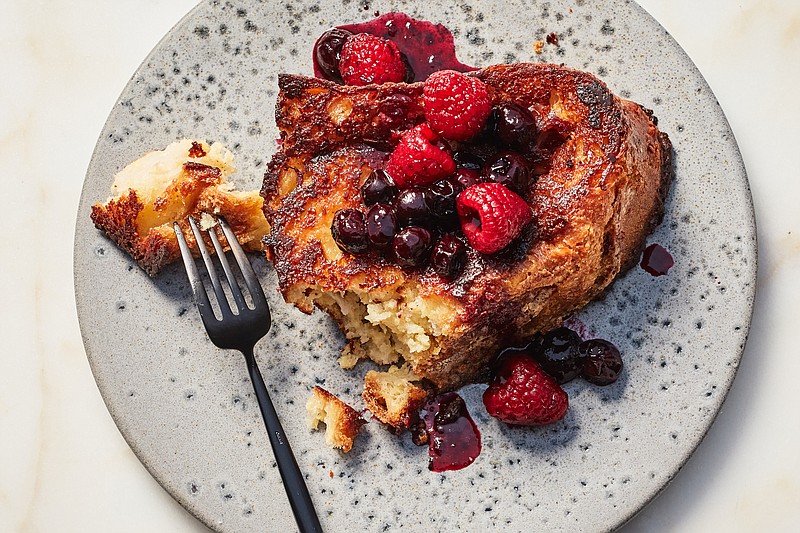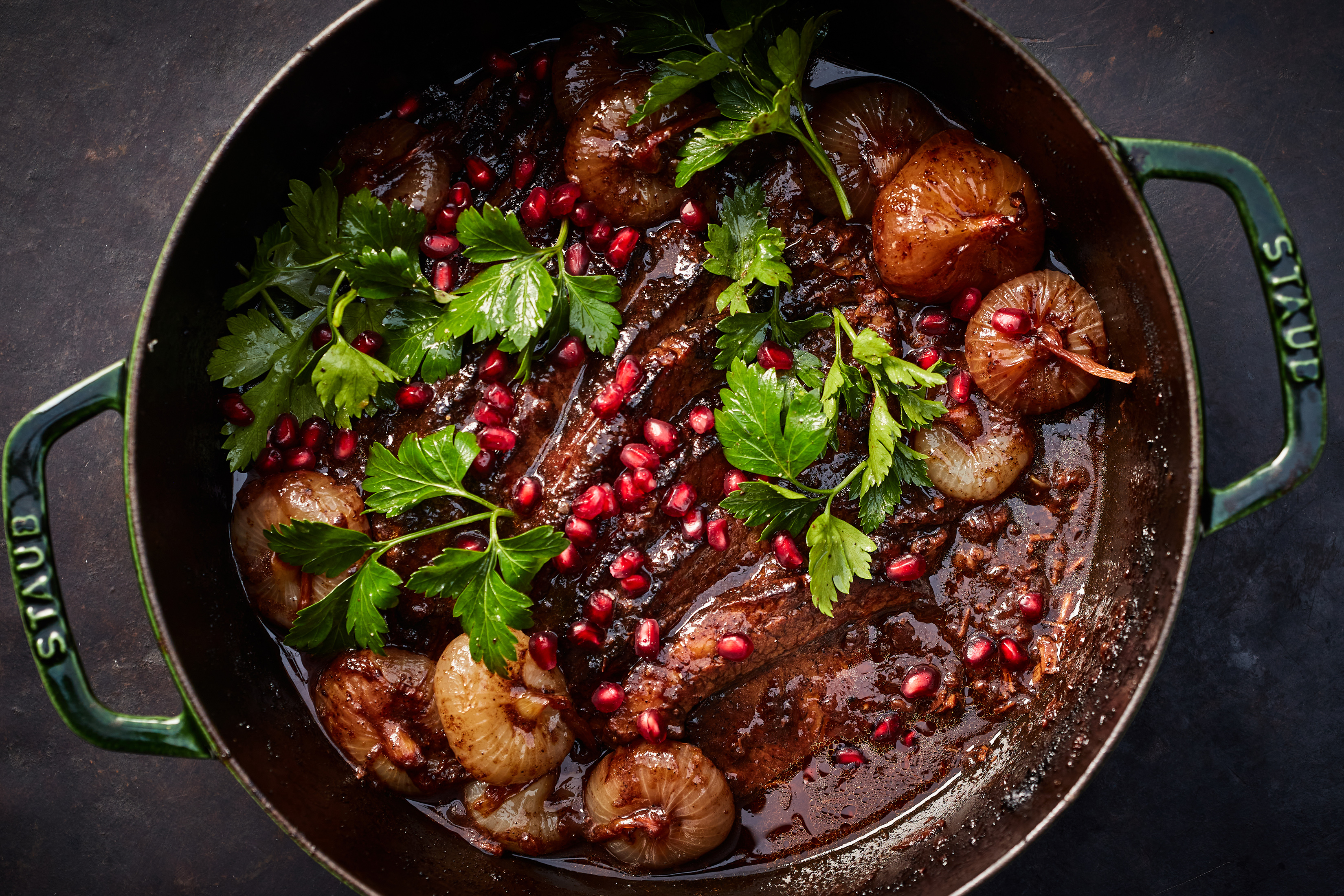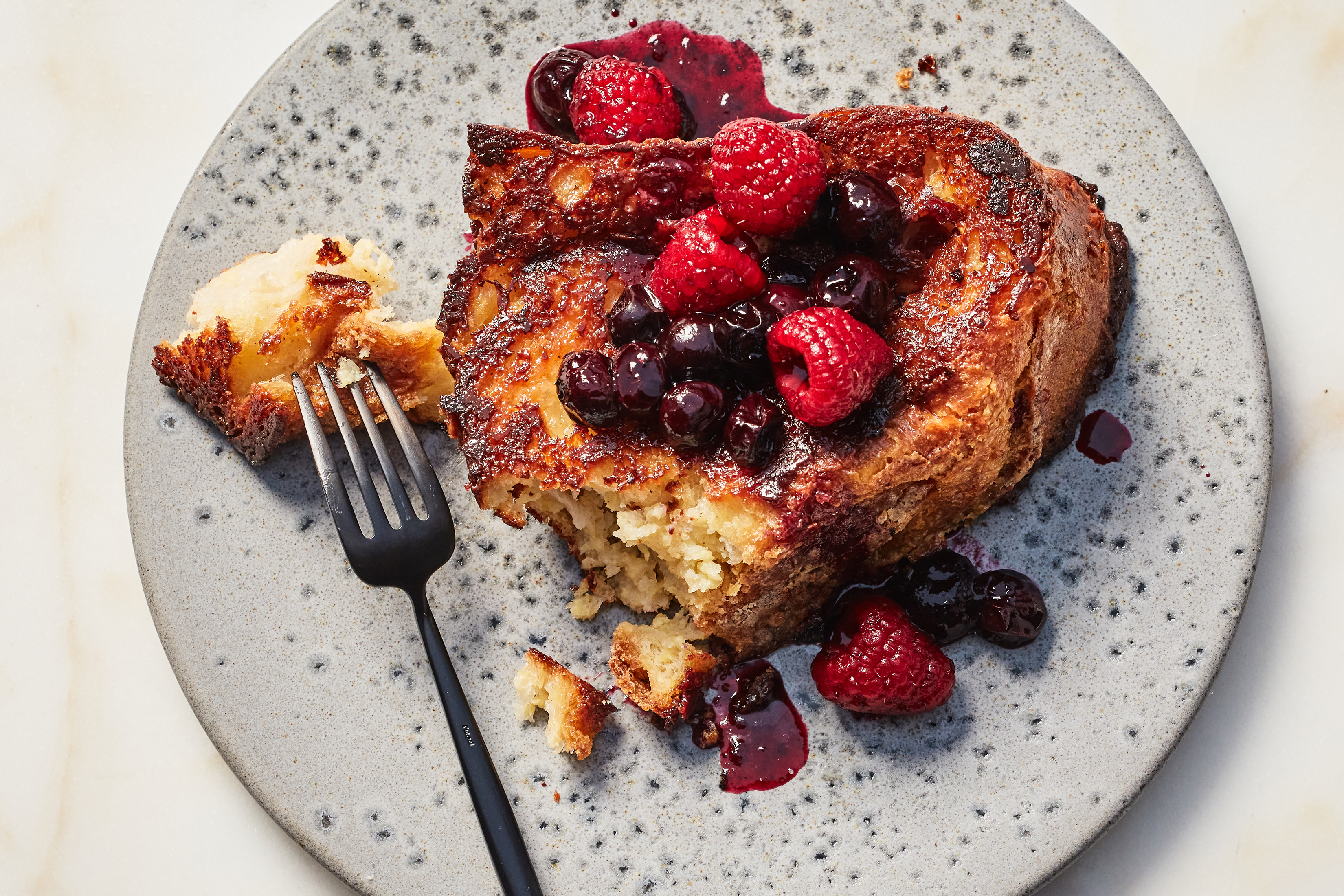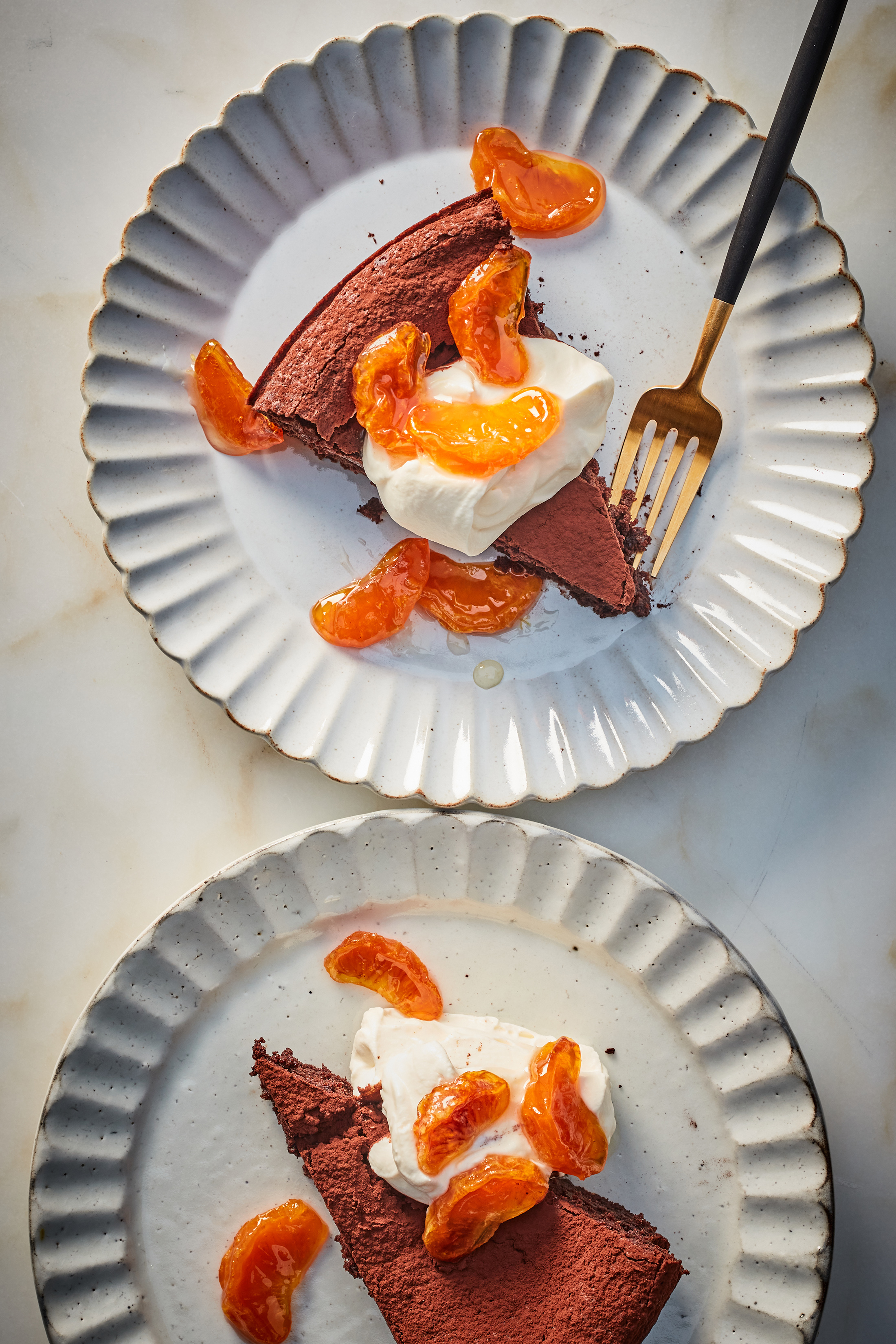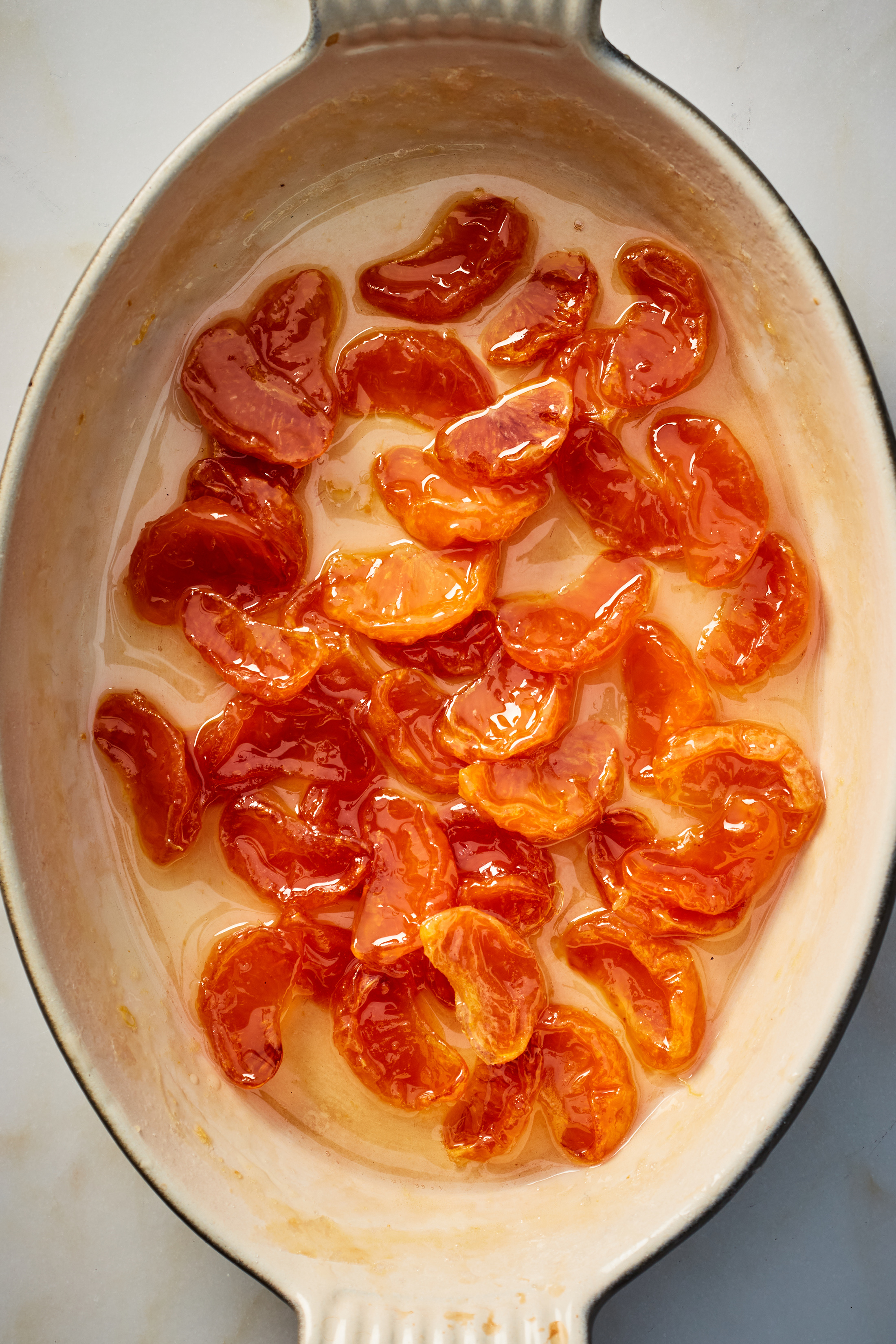Some of the very best dishes are those that take a long time - time you never used to have. These comforting but festive holiday recipes don't require much prep time or hands-on attention, but they do need you to be around the house. You just have to wait while the dishes fill your home with the aromas you want this time of year.
Case in point: Braised brisket takes only 30 minutes to be ready for the oven, but its spiced, meaty scent will waft through the kitchen for the next four hours or so. And it needs that time. If not cooked long enough, brisket's leaner and more readily available first cut, or flat cut, can be tough and dry. The meat seems to tighten as it cooks until all of a sudden it relaxes into tenderness, like a rubber band that finally snaps. After the meat is sliced, it gets heated in the sauce to further tenderize it and ensure it's moist.
For a sweeter note, slow-cook clementines in syrup. The French tradition of cooking whole fruit in sugar over days produces glasslike orbs that are lovely to look at but are more of a conversation piece. This clementine confit is a decidedly edible version that captures the spirit of the method, with less sugar and time but just as much beauty and a lot more ease.
Segments of the fruit go into simple syrup, then into the oven for two to three hours. This process is more about transformation than preservation. During this time, they morph into something more complex, chewy, concentrated and kind of fancy. They're perfect for topping a simple ginger chocolate cake that's everything a chocolate cake should be: easy, gorgeous and just rich enough. It may remain in your repertoire forever.
The same can be said of this sheet-pan French toast. Invest 10 minutes in thickly slicing bread and whisking together eggs, flavorings and milk, then combine them to soak overnight in the fridge. The next morning, the slabs of bread emerge from the oven custardy on the inside with a crisp caramel shell.
While tending to French toast on the stovetop is fine, it requires constant attention and can be a bit messy. The even heat of the oven and a sheet pan do a better, more foolproof job at caramelizing the bread to the burnish you're after. It's also relatively hands-off, except for two easy turns with tongs. Scaled up for a bigger batch, this recipe saves you from being stuck behind a stove, short-order cooking.
All of these dishes do. That they can sit for at least a day after being prepped, and before serving, adds to their leisurely vibe and may just make you want to always stay home.
Spice-Rubbed Braised Brisket
Yield: 8 to 10 servings
Total time: 5 hours
For the brisket:
2 tablespoons finely ground coffee
1 tablespoon smoked paprika
1 teaspoon ground coriander
1 teaspoon garlic powder
1/2 teaspoon ground cinnamon
1/2 teaspoon black pepper
2 1/2 teaspoons kosher salt
1 (4- to 5-pound) first-cut brisket
2 tablespoons olive oil
1 large onion, sliced
6 garlic cloves, peeled
1/2 cup dry red wine
1 1/2 cups pomegranate juice
1 cup chicken stock or water
1 1/2 pounds cipollini onions or small shallots, peeled
For serving:
1 cup lightly packed Italian parsley leaves with tender stems
1 teaspoon lemon juice (from 1 lemon)
2 teaspoons olive oil
Kosher salt and black pepper
1/2 cup pomegranate seeds
Mashed potatoes, for serving
1. Make the brisket: Heat oven to 300 degrees. In a small bowl, combine the coffee, smoked paprika, coriander, garlic powder, cinnamon, pepper and 2 teaspoons salt. Mix well, and rub all over the brisket.
2. Heat a large Dutch oven over medium. Add the oil, and brown the brisket, taking care not to burn the spices, about 5 minutes per side. Transfer to a plate.
3. Reduce the heat to medium-low. Add sliced onion, garlic and remaining 1/2 teaspoon salt. Cook, stirring occasionally, until the onion is softened and golden, 8 to 10 minutes.
4. Add the red wine, scrape up any brown bits and reduce the liquid by half. Add the pomegranate juice and stock. Bring to a simmer, and return the brisket to the pot with the fatty side up. Cover with the lid, place in the center of the oven, and braise until fork-tender, about 3 1/2 hours, basting every hour or so.
5. Uncover and nestle the cipollini onions in the liquid. Cover and braise in the oven for another 45 minutes. The meat should be very tender. Uncover and carefully transfer the meat to a cutting board. Let stand until cool enough to handle.
6. Meanwhile, scoop the cipollini onions into a bowl with a slotted spoon. Pour the sauce into a fat separator or a tall container, and remove as much fat as you can. Pour the sauce back into the pot, slice the meat and return it to the pot along with the onions, using a brush or spoon to encourage the sauce between the slices. Heat the broiler with the rack 8 inches from the heat source.
7. Partly cover the Dutch oven, and bring to a boil over high heat. Reduce the heat to simmer until the meat is completely warmed through. Remove the lid, and transfer the Dutch oven to the broiler. Broil, basting a few times, until the sauce thickens and the top is glazed, about 8 minutes.
8. To serve, dress the parsley with the lemon juice, olive oil, salt and pepper, and sprinkle over top along with the pomegranate seeds. Serve immediately with mashed potatoes.
Tips: You can make the brisket up to three days before serving. After it braises, let cool to room temperature in the Dutch oven. If you have the space, refrigerate the Dutch oven. Otherwise, remove the meat and onions to one container and the sauce to another. When ready to serve, slice the meat across the grain. Remove the hardened fat from the sauce and discard. Return the sauce to the Dutch oven. Place the sliced meat and onions in the sauce, using a brush or spoon to encourage the sauce between the slices. Proceed as above from Step 6.
Caramelized Sheet-Pan French Toast
Yield: 4 servings
Total time: 40 minutes, plus overnight soaking
3 large eggs
1 large egg yolk
1 cup whole milk
1/2 cup heavy cream
Pinch of kosher salt
1 teaspoon vanilla paste or extract
A few gratings of fresh nutmeg
1/4 teaspoon ground cardamom
1/2 cup plus 2 tablespoons sugar
1 tablespoon orange or grapefruit liqueur (optional)
2 (2-inch-thick) slices sourdough or country bread, halved
2 tablespoons unsalted butter
Maple syrup and berries, for serving
The day before serving, in a medium bowl, combine eggs, egg yolk, milk, cream, salt, vanilla, nutmeg, cardamom, 2 tablespoons sugar and the liqueur, if using. Whisk well until thoroughly combined.
Place the bread in a gallon-size resealable plastic bag or shallow dish that will fit the slices snugly. Pour the egg mixture into the bag or dish to soak in the refrigerator for at least 8 hours. If in a bag, lay on a plate and turn the bag over from time to time. If in a dish, cover and flip the slices carefully now and then to ensure even soaking.
When ready to cook, heat oven to 425 degrees. Remove the slices from the bag or dish, letting any excess drip off, and place on a plate. Coat the bread evenly with the remaining 1/2 cup sugar.
Heat a sheet pan or large cast-iron skillet in the oven for 5 minutes. Add 1 tablespoon butter to the pan. Spread it around, and add the sugarcoated bread, spacing evenly. Reduce heat to 400 degrees. Cook until the bottoms are evenly burnished and golden brown, 14 to 18 minutes.
Flip the bread, and add the remaining tablespoon butter in slivers around the slices. Cook until the bottoms are nicely browned, 7 to 8 minutes. Turn the slices on the cut ends to caramelize, 4 to 5 minutes. Serve immediately with the syrup and berries.
Tip: To make a simple berry compote topping, heat blueberries in maple syrup until warm and nearly bursting. Remove from the heat, and fold in raspberries.
Ginger Chocolate Cake
Yield: 8 to 10 servings
Total time: 1 1/4 hours, plus cooling
3/4 cup unsalted butter (1 1/2 sticks), plus softened butter for greasing the pan
12 ounces bittersweet chocolate (60%), broken into small pieces
1/4 cup Dutch-processed cocoa powder, plus more for dusting
1 rounded tablespoon grated peeled fresh ginger
1 1/4 teaspoons ground ginger
1 teaspoon vanilla extract
1/2 teaspoon kosher salt
1 (8-ounce) container crème fraîche (1 cup)
1 cup sugar
1 tablespoon ginger liqueur or cognac (optional)
6 large eggs, separated
Clementine Confit, for serving
Heat oven to 350 degrees. Grease the bottom and sides of a 9-inch springform pan with the softened butter. Line the bottom with parchment, and butter the paper.
Combine the butter and chocolate in a medium bowl, and set the bowl over a pan of barely simmering water. Stir occasionally until mostly melted, and remove from heat. Continue stirring until smooth, and let cool slightly. Add cocoa, fresh ginger, ground ginger, vanilla, salt, 1/4 cup crème fraîche, 1/4 cup sugar and the liqueur, if using. Whisk until smooth. Lightly beat the egg yolks in another bowl, and whisk into the chocolate mixture until smooth. Set aside in a warm place to keep the mixture loose.
Meanwhile, use a stand mixer fitted with the whisk or a hand mixer and large bowl to beat the egg whites on medium speed until evenly foamy. Gradually sprinkle in the remaining 3/4 cup sugar. Increase the speed to high, and continue beating until the egg whites are very billowy and hold a peak.
Add 1/4 of the whites to the chocolate mixture and whisk until smooth, then scrape into the bowl with the whites. Fold gently until no white streaks remain. Scrape into the prepared pan, and smooth the top. Place on a baking sheet and onto the center oven rack.
Bake until the center bounces a little when you gently shake the pan and a toothpick inserted 1 1/2 inches from the edge comes out clean, 40 to 45 minutes. Cool completely on a rack.
Remove the ring and slide onto a serving plate from the pan bottom. You can leave the paper in place. Gently pat any crumbling edges back onto the cake. The cake will last well wrapped at room temperature for a few days and can also be frozen.
When ready to serve, chill a bowl and whisk, and use them to whip the remaining 3/4 cup crème fraîche. It will thin out at first, then hold its shape. Dust the cake with cocoa powder, and slice with a hot knife. Serve each slice with a dollop of crème fraîche and some of the clementine confit.
Tips: You can substitute 1/4 cup sour cream for crème fraîche in the batter. Serve the cake with whipped cream if you'd like.
Clementine Confit
Yield: About 1/2 cup
Total time: 2 1/2 hours
4 clementines (10 ounces), peeled and segmented
1/2 cup sugar
Heat oven to 275 degrees.
Arrange the clementines in a single layer in a small baking dish that fits them snugly. Heat sugar and 1/2 cup water in a small saucepan, and simmer until the sugar is dissolved. Pour over the clementines, stirring gently to coat.
Bake, stirring every 45 minutes or so, until the segments are slightly translucent and tinged brown on the edges, 2 1/4 to 3 hours. Cool completely. Use immediately, or cover and store in the syrup. The clementine confit will last for a week at room temperature.
